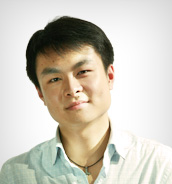Section B
Passage One
Human beings enjoy challenges. Many of them like physical challenges. They ask themselves questions like these: How fast can I run? How high can I climb? How deep can I dive? How far can I swim? How long can I hold my breath? How much can I lift? How high can I jump? Because people enjoy challenges, they like to play sports and watch other people play sports. They like climbing, running, diving, lifting, jumping, and so on. Every four years millions of people all over the world enjoy the international sports competition called the Olympics. There are challenges that are not physical challenges. There are social and intellectual challenges, too. Leonardo da Vinci, who lived in Italy during the fifteenth century, enjoyed every possible challenge. He was an artist and painted the well known picture, the Mona Lisa. He was an engineer who made plans for a city with roads under the street for traffic. He was an inventor who invented a device to let people breathe under water. He was a scientist, and he learned a great deal about human structure.
Another kind of challenge faced the Egyptians between 4,000 and 5,000 years ago when they decided to build the first pyramid. They used six million tons of rock. That is enough to build a ten foot wall around all of France. Four hundred thousand men worked for twenty years to build it.
So, for thousands of years, people accepted challenges. Today we still have many challenges before us. Medical science faces the challenges of conquering the many diseases which still attack human beings. Engineers and planners must build new cities and new kinds of transportation. Scientists must develop new forms of energy. And many of us are interested in the challenge of space. We live in an age of challenge.
Questions 26 to 28 are based on the passage you have just heard.
26. When people participate in sporting activities, what kind of challenge do they face?
【解析】选[B]。预读选项可知此题询问的是challenge的类型。在听的过程中需要留意涉及类型的细节。文中开头的Many of them like physical challenges后用一系列的例子,如How fast I can run?...They like climbing, running...表明,当人们参加体育活动时他们面对的是physical challenges。
27. Which belongs to social challenge?
【解析】选[D]。预读选项可以推测此题是考查对四种行为在细节上的区分。在听的过程中需要留意文中出现了哪几种行为、分别是为了说明什么问题而出现。
28. How do people react to the category of social challenges?
【解析】选[C]。预读选项可以推测此题是考查They对them的态度。在听问题时需要留意They和them分别指代的是什么。
Passage Two
Today we’ll examine the role that private transportation — namely, the automobile — plays in city planning.
A number of sociologists blame the automobile for the decline of the downtown areas of major cities. In the 1950’s and 1960’s the automobile made it possible to work in the city and yet live in the suburbs many miles away. Shopping patterns changed; instead of going to downtown stores, people in the suburbs went to large shopping malls outside the city and closer to the home. Merchants in the city failed, and their stores closed.
Downtown shopping areas became deserted. In recent years there’s been a rebirth of the downtown area, as many suburbanites have moved back to the city. They’ve done this, of course, to avoid highways blocked with commuters from the suburbs. I’ve chosen this particular city planning problem—our dependence on private transportation — to discuss in groups. I’m hoping you will all come up with some novel solutions. Oh, and don’t approach the problem from a purely sociological perspective; try to take into account environmental and economic issues as well.
Questions 29 to 31 are based on the passage you have just heard.
29. How did the automobile affect the work force in the 1950’s and 1960’s?
【解析】选[B]。预读选项可以推测此题是考查对It对workers或jobs的影响。在听问题时需要留意It指代的是什么。
30. What problem did downtown city merchants face in the 1960’s?
【解析】选[C]。预读选项可知此题是考查对四种负面事实的区分,需要留意文中关于这些细节的陈述。
31. According to the speaker, why are some people moving back to the city?
【解析】选[D]。预读选项可知此题询问的是关于某件事情的原因。文中提到人们从乡下搬回到城市的原因是:to avoid highways blocked with comustters...,[D]是对此的同义转述。
相关推荐:2007年英语四级预测试卷标准听力(三)
更多信息请访问:考试吧四六级栏目
>>>来四六级论坛看看吧
>>>四六级博客圈,你开博了吗?














